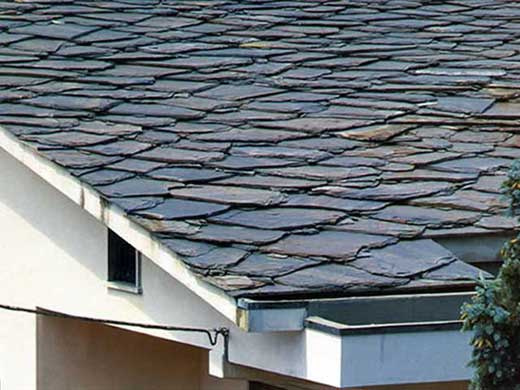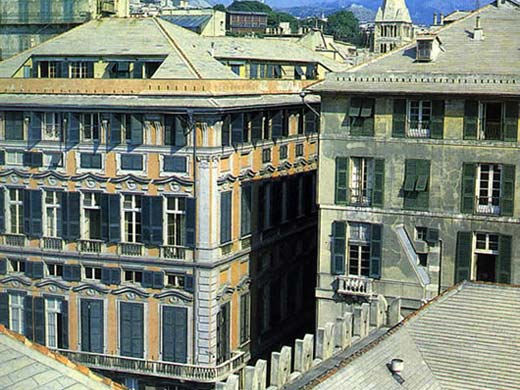Loading color scheme

Slate is, more than ever before, the ideal roofing material, thanks to its totally natural origin and, therefore, its eco-friendliness.
Among the innumerable qualities of slate roofing is, most of all, aesthetically speaking, its undeniable elegance. Here we summarise some of the unique physical and chemical characteristics of slate roofing, which guarantee:
Slate is guaranteed to withstand wear, which it seems to challenge without giving up, as shown by numerous old slate roofs throughout Liguria..
SLATE FOR ROOFTOPS
Thanks to its splendid, unmatched colours ranging from wolf grey and to its original “warm”, soft material in its streaked form, slate rooftops are elegant, classical and modern at the same time, totally natural and therefore eco-friendly, in other words, totally unique.
Slate is naturally waterproof and cannot be slipped on. It is therefore ideal for floors and facades.
Widespread in Genoa and notably characterising the city skyline, the Ligurian-style triple roofing is the most common style found on the most prestigious houses of coastal cities.
It differs markedly in appearance from the rustic tiles typical of country houses in the Ligurian Riviera, and its installation necessitates careful work.
Installation techniques of Ligurian-style triple roofing
The realisation of hooked triple roofing occurs after the placement of the strips, distanced from each other via an appropriate measuring device.
Starting from the lowest register or “gronda”, as with other types of roofing, which has different dimensions from other dormers, the strips are deposited in such a way that each overlaps by 2/3 with the dormer of the underlying register.
In this manner, the roofing has its slates overlapping each other three times.
The hook, shaped accordingly, is inserted in the space between one dormer and another. Consequently, it is covered by the dormer of the successive register.

In this scheme, we present Ligurian-style double roofing, also known as double overlapping, seeing as the strips are deposited in such a way that each one overlaps at half the length of the lower strip. Proceeding in this manner, one arrives at the point of having a roof in which the same slates have a double overlap.
Here too, the hook, shaped appropriately, is covered by the successive strip.

In this scheme, we present the Genoese-style roof, also known as “Genoese-style triple strip roofing”.The building of such roofing is done through mortar and cement interposed between the slabs, which are placed on a layer either made of wooden plank or volterra. Starting from the eaves, which are of a different size from the other strips, they are deposited in such a way that each one overlaps by two thirds on the strip of the underlying register. Proceeding in this way, one gets a roofing in which the same slates overlap three times.
For the Genoese-style roof, the slabs can also be held in place by zinc nails.

Here, we present the Piedmontese-style roof. The “Piedmontese” slab is particularly praised and increasingly sought after for its aesthetic appeal. It differs from the classically shaped slab by being notched on two angles. The installation of the Piedmontese-style roof, be it double or hooked, is done after the placement of the strips, distanced from each other via an appropriate measuring device.
Starting, as with other types of roofing, from the lowest register or the eave, which differs in size from the other slates, they are installed in such a way that they overlap by ½ on the underlying slab.
Proceeding in this way, one arrives at the point where the slates doubly overlap each other.
The hook, shaped appropriately, is inserted in the space between two tiles in such
Here, we present the French-style roof which differs from the others by the shape of the slabs, which are distributed in diamond shaped motifs. The shape of the strips are sometimes modified in a hexagonal shape, though this does not change the final design of the roofing.
The installation of the double-overlap, French-style roof can be done with zinc nails.
As with the others, installation begins on the lower register, or eave, with slabs differing in size from the others. They are placed in such a way that they overlap by ½ over the successive slab layer. In this way, one attains a form of roofing in which the same slates doubly overlap with each other.

Here we present the sliced roof, also known as rustic montane roofing. When viewed from the side, it gives off an irregular appearance.
The montane roofing can have a double or triple overlap. The latter ensures the roof’s longevity, but can be applied only in cases in which the structure supporting the roof is sufficiently solid, due to increased thickness. Installation can be done with zinc nails and, eventually, with mortar.
.jpg)
Scale roofing is used primarily for curved surfaces, like church domes or bell towers.
Nails and/or mortar are necessary for installation.
The installation of dome roofing starts underneath with slate registers that gradually decrease in size as the diameter of the dome narrows.
The placement of every register also involves tapering upwards the single slabs to ensure tiling. It therefore follows that curved scale roofing is a very demanding job, necessitating highly skilled workers.
Semi-circular curvature on the lower part of the slab facilitates installation on the rounded surface.

Historically used for curved surfaces, scale roofing has in recent years also been applied to linear surfaces. In these cases, the installation can be done via hooks.
Slate scale roofing is ideal for emphasising the size of the roofs of great villas or rustic, traditional housing.
The scale-shaped slabs require careful work in order to shape them in such a way that each one fits on the underlying piece.

Any type of roofing is naturally completed by some characteristic elements that blend with the roof.
The chimney, or external exhaust tube, is the most visible element, and today constitutes the rationalisation of the historical product.
The chimney consists of two U-shaped slate shelves fixed on the underlying wall, leaning on four vertical slabs linked by nails or metal links.
Inside this box, where the wall proceeds to about half its height, a fifth slab is slightly inclined in order to allow the outflow of water.
The chimney’s draft is ensured by four lateral openings on the wall, where a horizontal slab is placed above.
The link between the roof flap and the wall is also constructed with slate slabs, in order to ensure further waterproofing to the underlying lead coat.
Con il termine “gronda” si intende specificatamente il primo registro di lastre verso il basso.
Queste sono normalmente di dimensioni maggiorate, misurando generalmente cm 60-70×90-100. Anche lo spessore è superiore. Tali caratteristiche assicurano maggiore stabilità della copertura contro gli agenti atmosferici.
L’estremo opposto della copertura è costituito dal colmo, in prossimità del quale avviene l’unione delle falde che devono essere coperte con un displuvio che può essere realizzato in ardesia o in coppi di terracotta.
Coppi per displuvio in ardesia
Il coppo per displuvio in ardesia viene ricavato da un massello di lunghezza variabile e viene fissato attraverso placche metalliche e chiodi zincati per assicurare l’impermeabilità.
Sotto il coppo in ardesia è buona norma inserire una lastra di piombo in modo da assicurare il collegamento impermeabile tra una falda e l’altra.
I coppi in cotto, invece, vengono disposti uno di seguito all’altro secondo la loro specifica inclinazione e vengono fissati attraverso malta di calce.
Mondialardesia realizza coperture in ardesia di colmi e gronde.